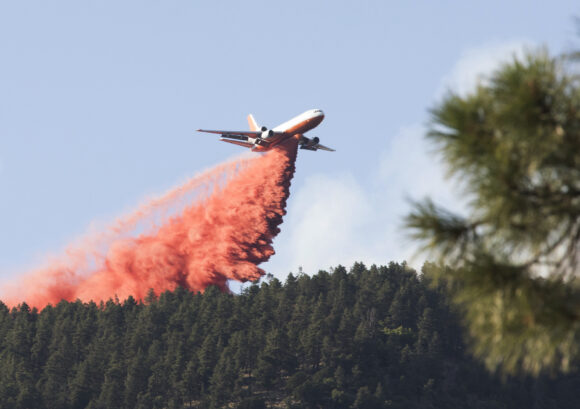FLAGSTAFF, Ariz. (AP) — Dozens of wildfires were burning in hot, dry conditions across the U.S. West, including a blaze touched off by lightning that was moving toward northern Arizona’s largest city.
The mountainous city of Flagstaff was shrouded in smoke Monday, and ash was falling from the sky. The national forest surrounding it announced a full closure set to begin later this week — the first time that has happened since 2006.
Intense heat that has hampered firefighting efforts more broadly was expected to moderate in the coming days. But, the National Weather Service noted it could bring uncertainty for fire crews.
“The humidity and the possibility of some scattered rainfall is a good thing,” said meteorologist Andrew Taylor. “The lightning is not a good thing.”
In California, firefighters still faced the difficult task of trying to contain a large forest fire in rugged coastal mountains south of Big Sur that forced the evacuation of a Buddhist monastery and nearby campground.
In New Mexico, lightning-sparked blazes have been scorching the southern part of the state where a large portion of the Gila Wilderness remains closed, and fire officials are closely watching the Gila Cliff Dwellings National Monument.
More land has burned across Arizona so far to date with new wildfire starts quickly shifting resources. While humans are to blame for an overwhelming majority of wildfires, lightning started a 31-square mile (80-square kilometer) blaze west of Sedona that was moving toward Flagstaff.
A top-tier management team had been ordered to oversee the blaze that’s burning in grass, juniper, chaparral and ponderosa pine.
Some campers already evacuated, and residents of rural areas have been told to prepare to evacuate on a moment’s notice, said Coconino County sheriff’s spokesman Jon Paxton.
If the fire continues its northeastern push, hundreds of people in Flagstaff — a college city about two hours north of Phoenix — also could be impacted, Paxton said.
Fire officials were mapping out a plan to starve the Rafael Fire of fuel as it moves through rugged terrain, canyons and wilderness, said fire information officer Dolores Garcia.
As of Monday, it was moving parallel to Interstate 40 along the Coconino and Yavapai county lines. The fire was about 16 miles from Flagstaff, but it’s hard to say how quickly it was spreading through various terrain, Garcia said.
Two national forests in northern Arizona made rare announcements to close completely to visitors starting Wednesday because of concerns they won’t have enough resources to respond to any future wildfires.
“We have limited resources, and we’re tapped right now,” said Brady Smith, a spokesman for the Coconino National Forest that surrounds Flagstaff.
The Coconino last issued a full closure in 2006. The nearby Kaibab National Forest, which borders the Grand Canyon, last fully closed in 2002. Both forests are popular for hiking, camping, fishing and other recreation because they sit at higher elevations and are much cooler than the state’s desert areas.
Arizona is at the highest level of preparedness for wildfires. Evacuations were in place for fires west of Phoenix, northeast of Tucson and near Heber. Some local roads also were closed.
A top-tier management team was overseeing a blaze near the communities of Pine and Strawberry where residents also were evacuated. The fire has burned among the treetops, with wind carrying flames far ahead.
Firefighting crews have yet to contain any of the wildfire’s perimeter. The lightning-sparked blaze was estimated at 51 square miles (132 square kilometers) Monday.
Firefighters in Oregon were focused on two wildfires, one burning near the state’s highest peak and another in the southern part of the state that was threatening 125 structures.
In Utah, several wildfires were burning in bone-dry conditions. The largest near the small town of Enterprise in southern Utah forced evacuations over the weekend. But homeowners were allowed to return as containment reached 50%.
–Associated Press writer John Antczak in Los Angeles and Andrew Selsky in Salem, Oregon, contributed to this report.
About the photo: In this Sunday, July 21, 2019, photo, a tanker releases a wave of fire retardant into the crest of a wildfire line in Flagstaff, Ariz. Crews on Monday were trying to keep the wildfire in a popular Arizona vacation area from homes and a ski resort. (Ben Shanahan/Arizona Daily Sun via AP)
Was this article valuable?
Here are more articles you may enjoy.


 ‘Super Roofs’ Are Rewarding Insurers, Cat Bond Investors and Homeowners
‘Super Roofs’ Are Rewarding Insurers, Cat Bond Investors and Homeowners  Abbott Presses Congress for Shield Over Preemie Baby Formula Litigation That Could Cost It Billions
Abbott Presses Congress for Shield Over Preemie Baby Formula Litigation That Could Cost It Billions  Florida And East Coast Will See Big Losses From More Cat 5 Storms, Researchers Say
Florida And East Coast Will See Big Losses From More Cat 5 Storms, Researchers Say  Thailand’s Record Floods Paralyze Key Hubs for Tech and Car Parts
Thailand’s Record Floods Paralyze Key Hubs for Tech and Car Parts 